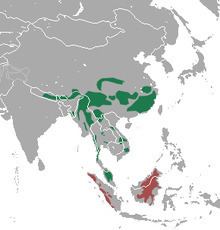Gestation period Clouded leopard: 93 days Rank Genus | Phylum Chordata Scientific name Neofelis Higher classification Pantherinae Length Clouded leopard: 84 cm | |
 | ||
Mass Clouded leopard: 12 – 23 kg Lower classifications Clouded leopard, Sunda clouded leopard | ||
The prettiest animal in the world neofelis nebulosa
Neofelis is a genus comprising two extant felid species from Southeast Asia: the clouded leopard (Neofelis nebulosa) of mainland Asia, and the Sunda clouded leopard (Neofelis diardi) of Sumatra and Borneo.
Contents
- The prettiest animal in the world neofelis nebulosa
- Taxonomic history
- Characteristics
- Distribution and habitat
- Distribution of species
- Threats
- Conservation
- References
The scientific name Neofelis is a composite of the Greek word νεο- meaning "new", and the Latin word feles meaning "cat", literally meaning "new cat".
Taxonomic history
The generic name Neofelis was first proposed by John Edward Gray in 1867 as comprising two species; Neofelis macrocelis occurring in the Himalaya, Malacca, and Thailand, and Neofelis brachyurus occurring in the former Formosa. Reginald Innes Pocock recognized the taxonomic classification of Neofelis in 1917, but admitted only the single species Neofelis nebulosa with several subspecies and macrocelis as the type specimen. For almost 90 years, the classification of Neofelis as a monotypic genus was widely accepted. In 2006, Neofelis diardi was found to be distinct from its continental relative Neofelis nebulosa and classified as a separate species.
Characteristics
Gray described the genus Neofelis as having an elongate skull, a broad and rather produced face on the same plane as the forehead, a large and elongate nasal, a moderate orbit, a truncated lower jaw and very long conical upper and lower canine teeth with a sharp cutting hinder edge. This skull has resemblances to that of the fossil Smilodon, with very much elongated upper canines.
Pocock described the skull of Neofelis as recalling in general features that of Panthera pardus, especially in the shortness and wide separation of the frontal and malar postorbital processes, relative proportion of mandibular teeth; but differing in the greater posterior width of the nasals, the thicker, more salient inferior edge of the orbit, and the mandible being greatly elevated anteriorly.
The Sunda clouded leopard has longer upper canines and a narrower palate between them.
Distribution and habitat
Neofelis species range from Nepal and Sikkim eastward to south China and Hainan, southeastward to Burma, Annam, the Malay Peninsula, Sumatra, Java and Borneo. They are most closely associated with primary evergreen tropical rainforest, but make use of other types of habitat. Sightings have also been made in secondary and logged forest, as well as grassland and scrub. In the Himalayan foothills they have been recorded up to 1,450 m (4,760 ft).
Distribution of species
Between 1821 and 1862, several felids have been described from Southeast Asia that are subordinated under Neofelis today:
Threats
Deforestation is the foremost threat for both Neofelis species. They are also threatened by commercial poaching for the wildlife trade. Skins, claws and teeth are offered for decoration and clothing, bones and meat as substitute for tiger in traditional Asian medicines and tonics, and live animals for the pet trade. Few poaching incidents have been documented, but all range states are believed to have some degree of commercial poaching. In recent years, substantial domestic markets existed in Indonesia, Myanmar and Vietnam.
Conservation
Both Neofelis species are listed in CITES Appendix I and are protected over most of their range. Hunting is banned in Bangladesh, Brunei, Cambodia, China, India, Indonesia, Malaysia, Myanmar, Nepal, Taiwan, Thailand, and Vietnam. Hunting regulations apply in Laos.
